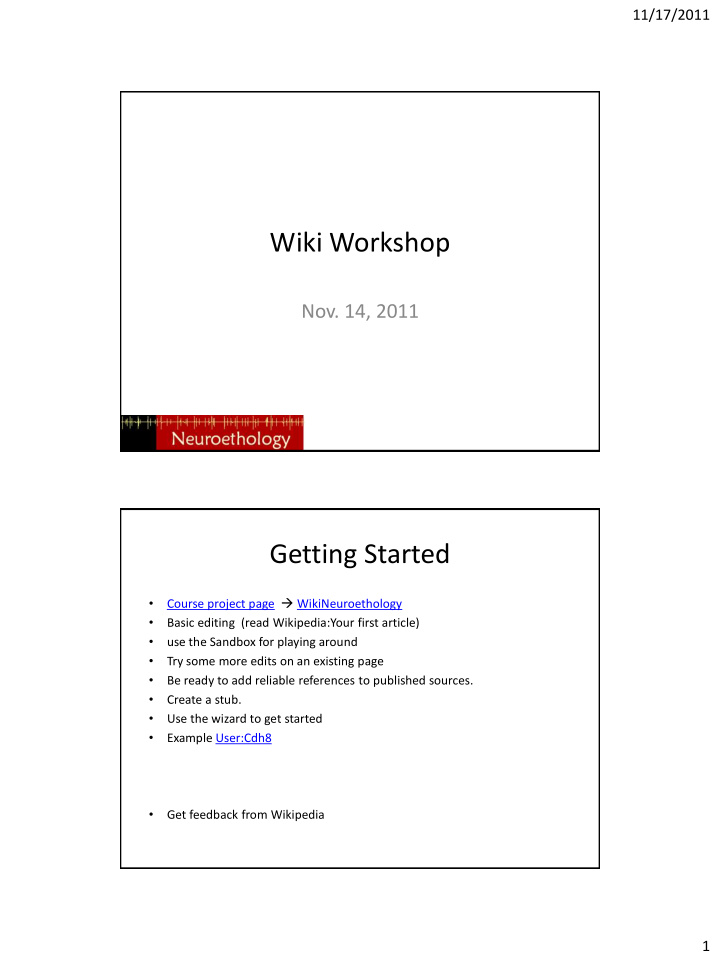



11/17/2011 Wiki Workshop Nov. 14, 2011 Getting Started • Course project page WikiNeuroethology • Basic editing (read Wikipedia:Your first article) • use the Sandbox for playing around • Try some more edits on an existing page • Be ready to add reliable references to published sources. • Create a stub. • Use the wizard to get started • Example User:Cdh8 • Get feedback from Wikipedia 1
11/17/2011 Inserting a Reference • Wikipedia: citing sources • Footnotes <ref>Hopkins, C. D. (1999). Design features for electric communication. Journal of Experimental Biology 202, 1217-1228. </ref> {{Reflist}} or <references /> How to create the list of citations The first editor to add footnotes to an article must create a section where the text of those citations appears. This section is placed at or near the bottom of the article and is usually titled "Notes" or "References." For more about the order and titles of sections at the end of an article (which may also include "Further reading" and "External links" sections), see Wikipedia:Footers. Shortcut: WP:ASLWith some exceptions discussed below, citations appear in a single section containing only the <references /> tag or the {{reflist}} template. For example: ==Notes=={{reflist}}The footnotes will then automatically be listed under that section heading. Each numbered footnote marker in the text is a clickable link to the corresponding footnote, and each footnote contains a caret which links back to the corresponding point in the text. Scrolling lists, or lists of citations appearing within a scroll box, should never be used. This is because of issues with readability, browser compatibility, accessibility, printing, and site mirroring. [1] If an article contains a list of general references, this is placed in a separate section, titled (for example) "References". This usually comes immediately after the section(s) listing footnotes, if any. (If the general references section is called "References", then the citations section is usually called "Notes".) Repeating citations For multiple use of the same citation or footnote, you can also use the named references feature, choosing a name to identify the citation, and typing <ref name=" name "> text of the citation </ref>. Thereafter, the same footnote may be reused any number of times by typing just <ref name= name />. For more details of this syntax, see Multiple references to the same footnote on the footnotes help page. 2
11/17/2011 Reference Lists Further reading Bear, M. F.; B. W. Connors, and M. A. Paradiso (2006). Neuroscience: Exploring the Brain (3rd ed.). Philadelphia: Lippincott. ISBN 0781760038. Binder/Hirokawa/Windhorst (2009, 4399pp, 5 vols). Encyclopedia of Neuroscience. Springer. ISBN 978- 3-540-23735-8. Kandel, ER; Schwartz JH, Jessell TM (2000). Principles of Neural Science (4th ed.). New York: McGraw- Hill. ISBN 0-8385-7701-6. Squire, L. et al. (2003). Fundamental Neuroscience, 2nd edition. Academic Press; ISBN 0-12-660303-0 Byrne and Roberts (2004). From Molecules to Networks. Academic Press; ISBN 0-12-148660-5 Sanes, Reh, Harris (2005). Development of the Nervous System, 2nd edition. Academic Press; ISBN 0-12- 618621-9 Siegel et al. (2005). Basic Neurochemistry, 7th edition. Academic Press; ISBN 0-12-088397-X Rieke, F. et al. (1999). Spikes: Exploring the Neural Code. The MIT Press; Reprint edition ISBN 0-262- 68108-0 Template:NeuroethologyNavbox • http://en.wikipedia.org/w/index.php?title=Te mplate:NeuroethologyNavbox 3
11/17/2011 Images Hyperlinks 4
11/17/2011 5
Recommend
More recommend